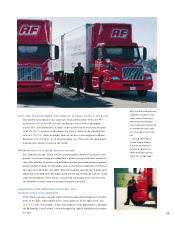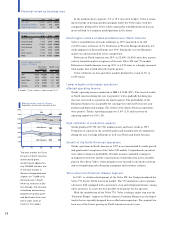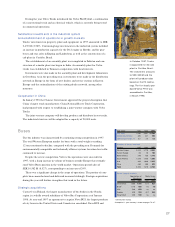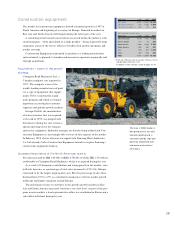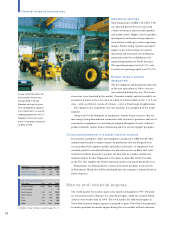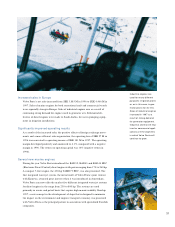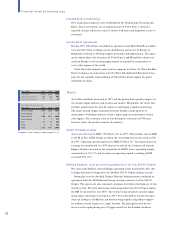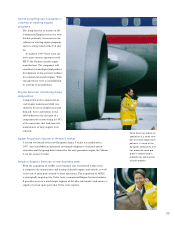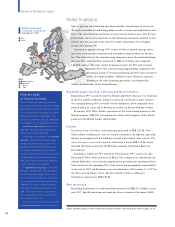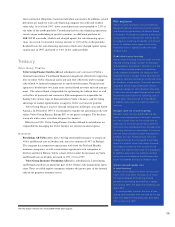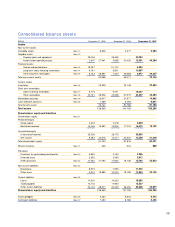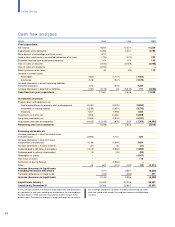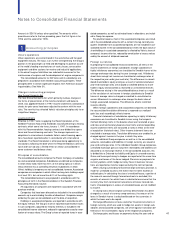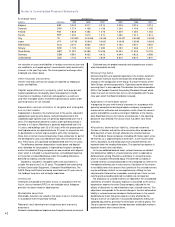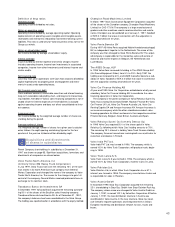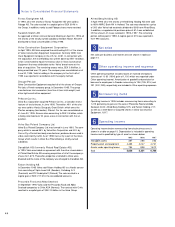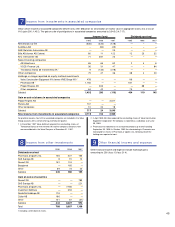Volvo 1997 Annual Report Download - page 37
Download and view the complete annual report
Please find page 37 of the 1997 Volvo annual report below. You can navigate through the pages in the report by either clicking on the pages listed below, or by using the keyword search tool below to find specific information within the annual report.
35
their contractual obligations, based on individual assessments. In addition, central
provisions are made for each sales-financing company for credit and residual
value risks. At year-end 1997, these central provisions corresponded to 2.3% of
the value of the credit portfolio. Considering that the sales-financing operations
entail a major undertaking in specific countries, an additional provision of
SEK 300 M was made, which is not charged against the sales-financing opera-
tions. As a result, total central reserves amount to 3.0% of the credit portfolio.
Realized losses for sales-financing operations which were charged against opera-
ting income in 1997 amounted to 0.2% of the credit portfolio.
Treasury
Volvo Group Finance
Volvo Group Finance Sweden AB and subsidiaries carry out most of Volvo’s
financial transactions. Coordinated financial management offers better opportun-
ities to utilize Volvo’s financial assets and cash flow effectively and to manage
risks related to financial management in a professional manner. Financial man-
agement is divided into two main areas: internal-bank activities and risk manage-
ment. The internal bank is responsible for optimizing the balance sheet as well
as the flow of payments and currencies. Risk management is responsible for
dealing with various types of financial risks in Volvo’s business, and for taking
advantage of market opportunities to improve Volvo’s net interest position.
Volvo Group Finance is active through subsidiaries in Europe, Asia and North
America. In December 1997 it was decided to transfer the operations in the sub-
sidiary Volvo Group Finance Europe B.V. to the parent company. The decision
was made with a view to further integrate the business.
Effective in 1998, Volvo Group Finance Sweden AB and its subsidiaries are
responsible for managing the Volvo Group’s net interest income/expense.
Insurance
Försäkrings AB Volvia offers direct-writing automobile insurance to owners of
Volvo and Renault cars in Sweden and, since the autumn of 1997, in Finland.
The company has cooperation agreements with both the Dial and Skandia
insurance companies, as well as reinsurance agreements with companies in
Norway and Great Britain. Volvia’s share of the market for insurance on Volvo
and Renault cars in Sweden increased to 35% (33) in 1997.
Volvo Group Insurance Försäkrings AB and its subsidiaries in Luxembourg
and Ireland constitute an important part of the Group’s risk-management opera-
tions. These so-called captive companies reinsure the greater part of the internal
risks in the property insurance sector.
The Volvo Group’s financial risks are described in Note 30 on page 53.
Risk exposure
Volvo’s finance operations are controlled by
groupwide policies which are revised annually
and thereafter approved by AB Volvo’s Board
of Directors. These policies pertain primarily to
various types of financial risks such as curren-
cy exposure, m atching of liquidity and interest
term s. In addition som e segm ents of sales
financing result in specific credit risk s and
residual risks.
Credit risks in sales financing
Volvo’s sales financing involves credit risks dis-
tributed am ong a large number of individual
end-custom ers and dealers. Collateral is in the
form of the financed products. In granting
credit, a balance between risk exposure and
expected return is sought. These activities are
guided by com m on policies for credit and rules
for customer classification. The credit portfolio
should be well distributed between various
custom er categories and individual industries.
Credit risks are m anaged through active credit
monitoring and routines for follow-up, and in
certain cases repossession of the products.
In addition, provisions are m ade to credit risk
reserves.
Residual value risk in sales financing
Residual value risks are attributable to con-
tracts involving operational leasing. It involves
the risk that the value of the leased item at
expiration of the leasing contract is different
than what was anticipated when the operation-
al leasing contract was concluded. This means
that the lessor may be forced to liquidate the
products at a loss. Residual value risk s are
managed through having a good k nowledge
about the m arket, know-how about the prod-
uct and price trends as well as activities to
support the second-hand value of the products.
In addition, provisions are made to residual
value reserves to balance the differences be-
tween anticipated and actual residual value.
Interest-rate and liquidity risks
in sales financing
Interest rate changes that occur during a con-
tract’s term m ay affect earnings. As a result,
the highest degree of matching of fixed
periods for borrowing and lending is sought.
At year end 1997, the degree of m atching was
about 90%.
In a com parable manner, the term of bor-
rowing shall correlate with the term of the con-
tract. This degree of m atching was also about
90% at year-end 1997.


